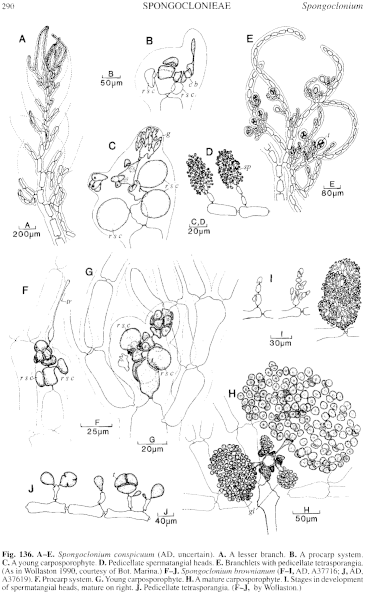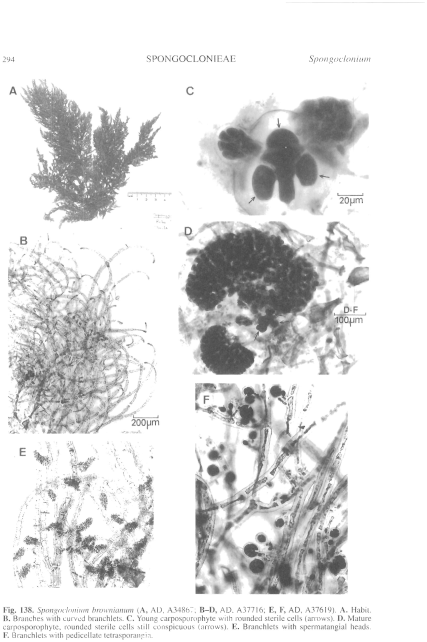|
|
|
|
|
|||||||||||
|
Electronic Flora of South Australia Species Fact Sheet
Phylum Rhodophyta – Order Ceramiales – Family Ceramiaceae – Tribe Spongoclonieae
Selected citations: De Toni 1903: 1358. Huisman & Walker 1990: 425. Lucas 1909: 49; 1927: 464, pls 28, 29; 1929b: 52. Lucas & Perrin 1947: 334. May 1965: 368. Mazza 1911: No. 385. Silva et al. 1996: 425.
Synonyms
Callithamnion brownianum Harvey 1855a: 561; 1863, synop.: li. J. Agardh 1876: 49. Sonder 1881: 10.
Pleonosporium brownianum (Harvey) Harvey-Gibson 1893: 164. De Toni 1924: 469.
Thallus (Fig. 138A) erect, medium red-brown, 3–15 cm high, irregularly alternately branched, usually with a main axis and well-developed laterals, corticated with rhizoids on mid and lower parts, ecorticate above. Holdfast rhizoidal, 2–8 (–12) mm across, epiphytic on Posidonia, Amphibolis or larger algae, or epilithic. Structure. Axial cells 27–55 µm in diameter near apices and L/D 1.5–2,200–700 µm in diameter and L/D 2–4 below, bearing spirally arranged ecorticate branched branchlets tapering from 25–55 (–100) µm in diameter, cells L/D 2–3, to 12–20 (–27) µm in diameter, cells L/D 1.5–3 (–4), near their apices, upper parts usually curved (Fig. 138B); cortical rhizoids 10–20 µm in diameter, cells L/D 3–8 (–12). Cells multinucleate; rhodoplasts discoid to elongate.
Reproduction: Gametophytes dioecious. Carpogonial branches (Fig. 136F) borne on the subterminal cell of fertile axes 4 to several cells long, the subterminal cell bearing the 4-celled carpogonial branch and the third cell bearing 2 opposite, sterile, periaxial cells (Fig. 138C), with the terminal and 2 sterile periaxial cells enlarging and becoming rounded. Post-fertilization the supporting cell cuts off an auxiliary cell and the carpogonium cuts off two connecting cells, with the carpogonial branch cells partially fusing. The auxiliary cell cuts off an apical gonimoblast initial which produces a first gonimolobe (Fig. 136G), then successively 3 or 4 more (Figs 136H, 138D), each 180–540 µm across, with subspherical carposporangia 10–27 µm in diameter; the supporting cell and sterile cells of the procarp fuse to form a darkly-staining triangular mass with 3 projecting cells. The fourth cell of the fertile axis and lower axial cells produce curved involucral filaments around the carposporophyte. Spermatangial heads (Figs 136 I, 138E) are elongate, 35–50 µm in diameter and L/D 2–4, sessile on lower cells of the branchlets, with 5–8 axial cells and outer spermatangia 2–3 µm in diameter.
Tetrasporangia (Figs 136J, 138F) are borne on lower cells of the branchlets, sessile or on 1–2-celled pedicels (which may produce a further tetrasporangium or a small fascicle), subspherical, 25–50 µm in diameter, tetrahedrally divided (rarely octosporangia).
Type from "Rottnest, Fremantle and King George Sound", W. Aust.; lectotype tetrasporangial (Harvey, Tray. Set 264) from King George Sound, in TCD.
Selected specimens: North Beach, Perth, W. Aust., drift, epiphytic (Wood, 6.x.1960; AD, A24560). Safety Bay, W. Aust., drift (Womersley, 18.viii.1979; AD, A50787). Elliston Bay, S. Aust., 7 m deep (Shepherd, 20.x.1970; AD, A37619). Tiparra Reef, S. Aust., 11 m deep on Amphibolis (Shepherd, 31.x.1970; AD, A37716). West I., S. Aust., 25 m deep (Shepherd, 29.i.1973; AD, A42963). Victor Harbor, S. Aust., drift (Womersley, 24.vii.1949; AD, A11148). Pennington Bay, Kangaroo I., S. Aust., drift (Womersley, 4.i.1948; AD, A6610). Robe, S. Aust., drift (Womersley, 11.xii.1969; AD, A34867). Lady Julia Percy I., Vic., 5–8 m deep on Acrocarpia (Shepherd, 3.i.1968; AD, A32383). Queenscliff, Vic., drift (Clayton & Gordon-Mills, 4.xii.1983; AD, A55430). Flinders, Vic., drift (Gordon-Mills, 9.xii.1983; AD, A55447). Pirates Bay, Eaglehawk Neck, Tas., 9–12 m deep (Lytle, 22.x.1994; AD, A64050). Safety Cove, Port Arthur, Tas., 7 m deep (Brown & Kenchington, 16.x.1986; AD, A57741).
Distribution: North Beach, Perth, W. Aust., to Flinders, Vic., and SE Tasmania.
Taxonomic notes: In TCD there are several specimens of Harvey's Tray. Set 264, including two from King George Sound, one tetrasporangial and one male. The former is selected as lectotype since Harvey originally described tetrasporangia.
S. brownianum differs from S. fasciculatum in dimensions of the broader branchlets, in producing procarps on relatively longer axes, and in having tetrasporangia either sessile or pedicellate.
S. brownianum var. majus Harvey (1863, synop.: li) from W. Aust. and Port Fairy, Victoria [lectotype Alg. Aust. Exsicc. 511, from Swan R., W. Aust. (Clifton)] appears to be only a larger form with denser branching.
References:
AGARDH, J.G. (1876). Species Genera et Ordines Algarum. Vol. 3, Part 1- Epicrisis systematic Floridearum, pp. i-vii, 1–724. (Weigel: Leipzig.)
AGARDH, J.G. (1892). Analecta Algologica. Acta Univ. lund. 28, 1–182, Plates 1–3.
DE TONI, G.B. (1903). Sylloge Algarum omnium hucusque Cognitarum. Vol. 4. Florideae. Sect. 3, pp. 775–1521 + 1523–1525. (Padua.)
DE TONI, G.B. (1924). Sylloge Algarum omnium hucusque Cognitarum. Vol. 6. Florideae. (Padua.)
HARVEY, W.H. (1855a). Some account of the marine botany of the colony of Western Australia. Trans. R. Jr. Acad. 22, 525–566.
HARVEY, W.H. (1863). Phycologia Australica. Vol. 5, Plates 241–300, synop., pp. i-lxxiii. (Reeve: London.)
HARVEY-GIBSON, R.J. (1893). On some marine algae from New Zealand. J. Bot. Lond. 31, 161–167, Plate 335.
HUISMAN, J.M. & WALKER, D.I. (1990). A catalogue of the marine plants of Rottnest Island, Western Australia, with notes on their distribution and biogeography. Kingia 1, 349–459.
LUCAS, A.H.S. & PERRIN, F. (1947). The Seaweeds of South Australia. Part 2. The Red Seaweeds. (Govt Printer: Adelaide.)
LUCAS, A.H.S. (1909). Revised list of the Fucoideae and Florideae of Australia. Proc. Linn. Soc. N.S.W. 34, 9–60.
LUCAS, A.H.S. (1927). Notes on Australian marine algae. IV. The Australian species of the genus Spongoclonium. Proc. Linn. Soc. N.S.W. 52, 460–470, Plates 27–35.
LUCAS, A.H.S. (1929b). A census of the marine algae of South Australia. Trans. R. Soc. S. Aust. 53, 45–53.
MAY, V. (1965). A census and key to the species of Rhodophyceae (red algae) recorded from Australia. Contr. N.S.W. natn. Herb. 3, 349–429.
MAZZA, A. (1911). Saggio di Algologia Oceanica. Nuova Notarisia 22, Nos. 369–393.
SILVA, P.C., BASSON, P.W. & MOE, R.L. (1996). Catalogue of the Benthic Marine Algae of the Indian Ocean. (University of California Press: Berkeley, Los Angeles & London.)
SONDER, O.W. (1881). In Mueller, F., Fragmenta Phytographiae Australiae. Supplementum ad volumen undecinum: Algae Australianae hactenus cognitae, pp. 1–42, 105–107. (Melbourne.)
The Marine Benthic Flora of Southern Australia Part IIIC complete list of references.
Publication:
Womersley, H.B.S. (24 December, 1998)
The Marine Benthic Flora of Southern Australia
Rhodophyta. Part IIIC. Ceramiales – Ceramiaceae, Dasyaceae
©State Herbarium of South Australia, Government of South Australia
Illustrations in Womersley Part IIIA, 1998: FIGS 136 F–J, 138.

Figure 136 enlarge
Fig. 136. A–E. Spongoclonium conspicuum (AD, uncertain). A. A lesser branch. B. A procarp system. C. A young carposporophyte. D. Pedicellate spermatangial heads. E. Branchlets with pedicellate tetrasporangia. (As in Wollaston 1990, courtesy of Bot. Marina.) F–J. Spongoclonium brownianum (F–I,D, A37716; J, AD, A37619). F. Procarp system. G. Young carposporophyte. H. A mature carposporophyte. I. Stages in development of spermatangial heads, mature on right. J. Pedicellate tetrasporangia. (F–J, by Wollaston.)

Figure 138 enlarge
Fig. 138. Spongoclonium brownianum (A, AD, A34867; B–D, AD, A37716; E, F, AD, A37619). A. Habit. B. Branches with curved branchlets. C. Young carposporophyte with rounded sterile cells (arrows). D. Mature carposporophyte, rounded sterile cells still conspicuous (arrows). E. Branchlets with spermatangial heads. F. Branchlets with pedicellate tetrasporangia.

|
Email Contact: State Herbarium of South Australia |

|